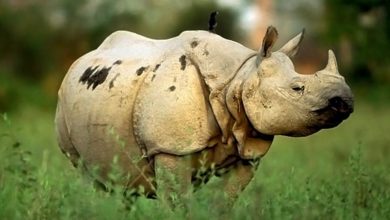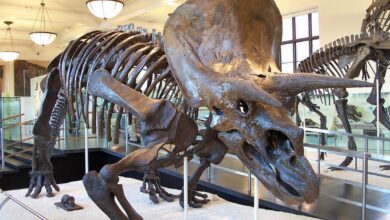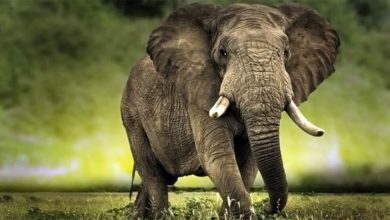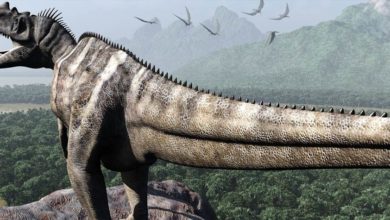Wildcat (Felis silvestris)
The wildcat (Felis silvestris) is a small wild cat living in Asia, Africa and Europe. It resembles an overgrown domestic cat and belongs to the family of predatory cats that also (besides the lynx) can be found in Europe. However, in comparison to the domestic cat, the wildcat’s build is more robust, although its coloration is very similar to the coloration of an ordinary alley cat.
Wildcat subspecies
There have been over 20 subspecies of the wildcat distinguished, and they are classified into three groups:
- European wildcat – Felis silvestris silvestris – found in Europe
- African wildcat – Felis silvestris lybica – found in Africa and on the Arabian Peninsula
- Asiatic wildcat – Felis silvestris ornata – found in Asia
The African wildcat is believed to be the ancestor of the domestic cat.

Classification
- Order: Carnivora
- Family: Felidae
- Genus: Felis
- Species: Felis silvestris (wildcat)
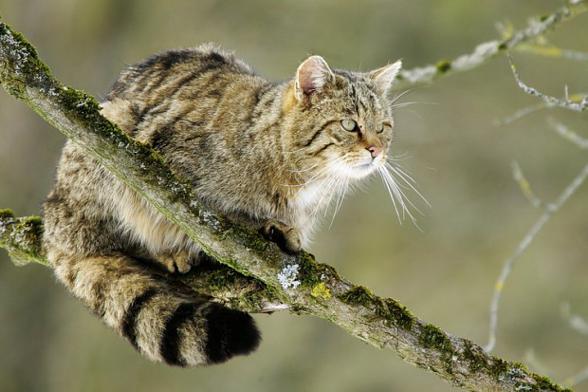
Occurrence
At present, wildcats inhabit the regions of:
- Europe (Scotland, the Iberian Peninsula, Germany, central France, the Italian Peninsula, the Carpathian Mountains, Sicily, Sardinia)
- Caucasus and Asia Minor
- They can also be found in India, China and Mongolia, as well as in Africa.
- About 200 individuals live in Poland, in the Eastern Carpathians.
The wildcat is very easy to crossbreed with the domestic cat. It means that probably all European wildcats are crossbreeds of wildcats and domestic cats.
Despite appearances, the wildcat doesn’t like to live in deep forests. It feels the safest at the edge of a deciduous or mixed forest, hiding among trees. However, it hunts in open space, such as meadows, glades, rivers and brook valleys.
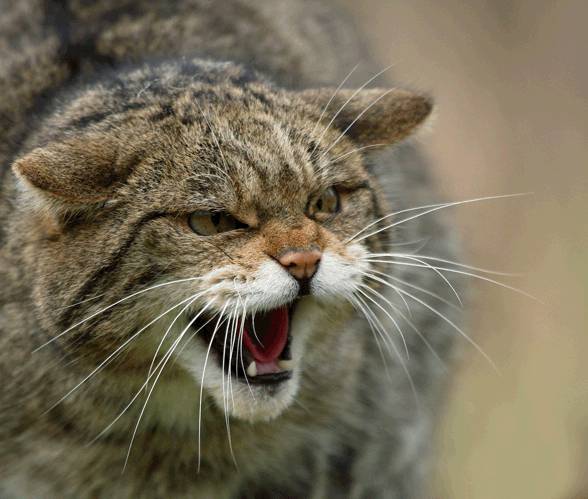
Appearance
The wildcat has beautiful, silky, and dense fur. In comparison to the domestic cat, the fur of the wildcat is a bit longer and darker. It can be mottled grey, yellowish-grey, dark grey. Stripes that are present on the sides of the body, the tail, and legs are the characteristic feature of the wildcat.
The characteristic dark stripe going along the back up to the tail is another feature that distinguishes the wildcat, however, the stripes on the tail do not connect with the back stripe, which differentiates the wildcat from the domestic cat in some sense. The stomach is much lighter than the rest of the fur. The wildcat has a pretty, fluffy, quite short tail, with a dark tip and rings. The tail is distinctly thicker at the tip.
The wildcat has a wide head, short, rounded ears, and a mahogany-colored nose (reddish-brown) that is surrounded by white whiskers. Legs – although short – are thick and strong, equipped with retractable claws.
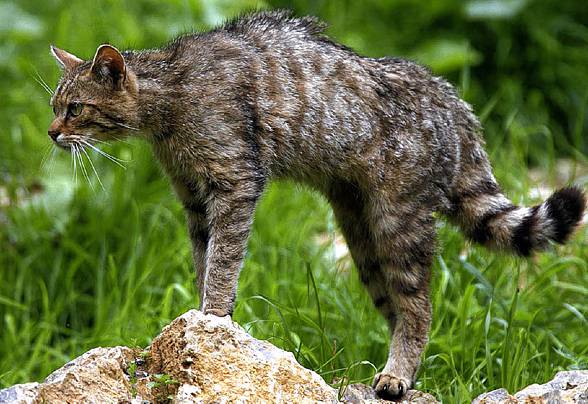
The inner toes on the fore paws are located high enough to not leave any tracks on snow or soft soil. Therefore, the tracks of the wildcat consist of four toes, despite it having five toes in fore paws.
When the wildcat is angry, it flattens its ears along the head, opens its jaws widely, and snorts loudly. It bristles and arches its back, which makes it seem bigger. It is a very good way to scare off an intruder.
When the wildcat walks slowly, it puts its hind paws in the place of the tracks left by the fore paws. The step length is 30-50 cm (11.8-19.7 in).
The step pattern of the wildcat creates an almost straight line.

Name
In English “wildcat” simply means “a wild cat”.
Habits
Like most predatory cats, the wildcat is solitary. In terms of social behaviors, it is similar to the lynx. Female territories are larger than male ones. The female territories adjoin each other and slightly overlap. Males have larger territories – their borders are distinctly marked and do not overlap. One territory of a male wildcat overlaps with several female territories. Males and females mate only during the mating season, which is at the turn of February and March.
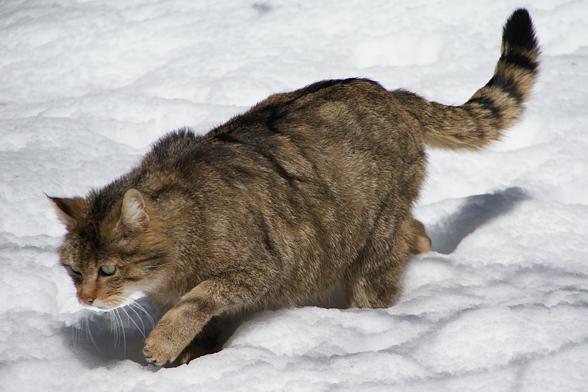
Hunting
The wildcat is a nocturnal hunter. It is active at dusk or in the middle of the night. Females travel less, but more regularly go around their territories, often coming back to the same lair. Males move fast, about 3-5 km/h (1.86-3.1 mph), they hunt almost the whole night.
The wildcat is great at climbing, but it doesn’t jump from one tree to another. It happens only when the animal is in danger. This cat hunts in two ways: from ambush or right away. It never waylays on trees, but only on the ground. The wildcat feeds on small rodents, birds, fish, frogs, it can also eat a small deer.
When the wildcat chooses its prey, it approaches by a few silent leaps or runs up to it with the speed “adjusted” to the potential prey. Right before the leap, the wildcat freezes. Attacking from ambush, the wildcat can stay in one place for several dozen minutes, seeming to be resting. When it senses the right moment, it stands up abruptly and runs towards the prey.
The wildcat eats about 600 g of food daily.
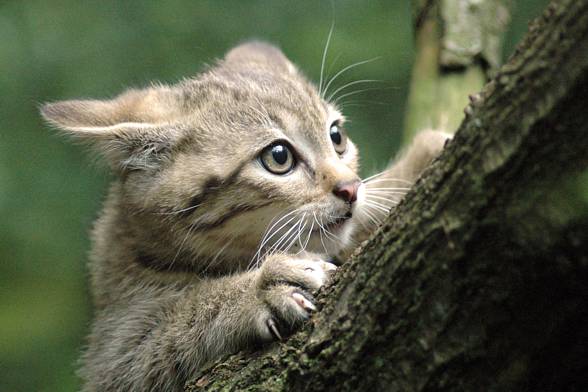
Gestation and parenting
The gestation period in wildcats lasts 63-69 days, and the female gives birth to 1-7 kittens. Each kitten weighs 80-120 g (2.8-2.23 oz). They are born blind and they open their eyes after a week. The female gives birth in a lair hidden under roots of fallen trees, in fox or badger lairs, or in hollows.
The young are fed with their mother’s milk for about 7 weeks (sometimes even for 4 months). After 5-6 months kittens are ready to live independently. They become sexually mature at 10-12 months old.
The wildcat can live 12-18 years in captivity. It certainly lives shorter in the wild because of threats, although there is no precise data concerning that matter.
There are over 20 wildcat subspecies in the world.

Detailed information and measurements
Wildcat (Felis silvestris)
- Length:
- males: 43-91 cm (16.9-35.4 in)
- females: 40-77 cm (15.7-30.3 in)
- Height at shoulders: 25-35 cm (9.8-13.8 in)
- Tail length: 18-40 cm (7.1-15.7 in)
- Weight:
- males: 5-8 kg (11-17.6 lb)
- females: 3-5 kg (6.6-11 lb)
- Lifespan: 12-18 years (in captivity)
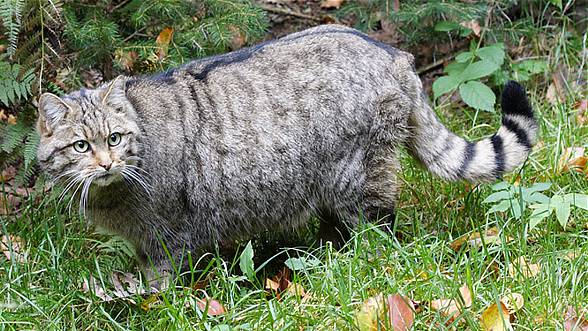
Wildcat – interesting facts
- The inner toes on the fore paws are located high enough to not leave any tracks on snow or soft soil. Therefore, the tracks of the wildcat consist of four toes, despite it having five toes in fore paws.
- The wildcat was entered into the group of protected animals.
- There are over 20 wildcat subspecies.
- It is believed that there are more crossbreeds of wildcats and domestic cats than pure wildcats in Europe.
- The wildcat eats about 600 g (21.1 oz) of food daily.
- The step pattern of the wildcat creates an almost straight line.
- The wildcat is one of the most mysterious animals. It hasn’t been known well because of its lifestyle and its typical “cat” personality.
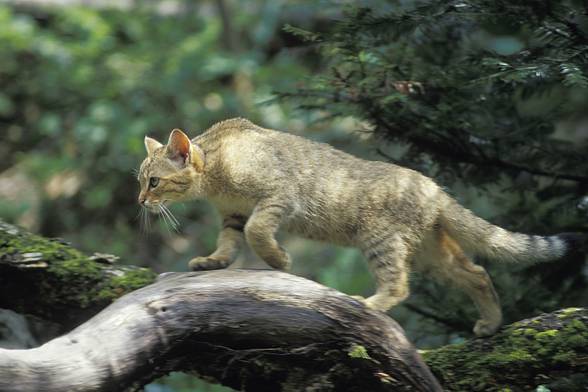
Recommended
- Persian leopard
- Amur leopard
- Siberian tiger
- Bengal tiger
- Sumatran tiger
- Indochinese tiger
- Malayan tiger
- South China tiger
- Tigers
- White tigers
- Lions
- White lions
- Lion vs tiger
- Liger
- Lynx
- Canada lynx
- Serval
- Ocelot
- Animal fights
- American lion
- European cave lion
- Smilodon – Saber-toothed tiger
- Fights of animals
- Big cats
- Black panther
- Leopard
- Snow leopard
- African Lion
- Fastest animals
- Fastest birds










